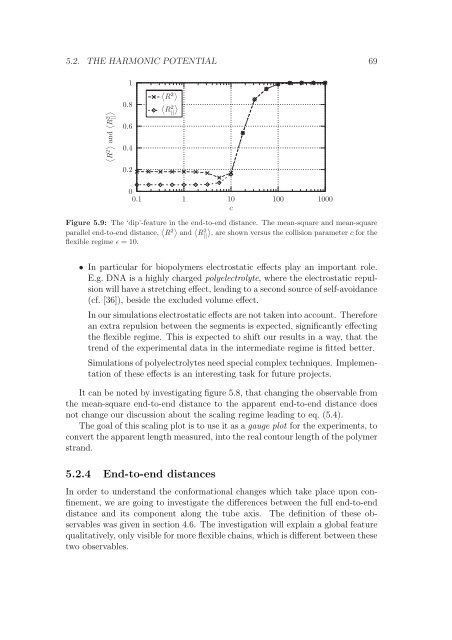Polymers in Confined Geometry.pdf
Polymers in Confined Geometry.pdf
Polymers in Confined Geometry.pdf
You also want an ePaper? Increase the reach of your titles
YUMPU automatically turns print PDFs into web optimized ePapers that Google loves.
5.2. THE HARMONIC POTENTIAL 69<br />
<br />
R 2 and R 2 ||<br />
1<br />
0.8<br />
0.6<br />
0.4<br />
0.2<br />
0<br />
0.1<br />
R 2 <br />
<br />
2 R|| 1<br />
Figure 5.9: The ‘dip’-feature <strong>in</strong> the end-to-end<br />
<br />
distance. The mean-square and mean-square<br />
, are shown versus the collision parameter c for the<br />
parallel end-to-end distance, R 2 and R 2 ||<br />
flexible regime ɛ = 10.<br />
10<br />
c<br />
100<br />
1000<br />
• In particular for biopolymers electrostatic effects play an important role.<br />
E.g. DNA is a highly charged polyelectrolyte, where the electrostatic repulsion<br />
will have a stretch<strong>in</strong>g effect, lead<strong>in</strong>g to a second source of self-avoidance<br />
(cf. [36]), beside the excluded volume effect.<br />
In our simulations electrostatic effects are not taken <strong>in</strong>to account. Therefore<br />
an extra repulsion between the segments is expected, significantly effect<strong>in</strong>g<br />
the flexible regime. This is expected to shift our results <strong>in</strong> a way, that the<br />
trend of the experimental data <strong>in</strong> the <strong>in</strong>termediate regime is fitted better.<br />
Simulations of polyelectrolytes need special complex techniques. Implementation<br />
of these effects is an <strong>in</strong>terest<strong>in</strong>g task for future projects.<br />
It can be noted by <strong>in</strong>vestigat<strong>in</strong>g figure 5.8, that chang<strong>in</strong>g the observable from<br />
the mean-square end-to-end distance to the apparent end-to-end distance does<br />
not change our discussion about the scal<strong>in</strong>g regime lead<strong>in</strong>g to eq. (5.4).<br />
The goal of this scal<strong>in</strong>g plot is to use it as a gauge plot for the experiments, to<br />
convert the apparent length measured, <strong>in</strong>to the real contour length of the polymer<br />
strand.<br />
5.2.4 End-to-end distances<br />
In order to understand the conformational changes which take place upon conf<strong>in</strong>ement,<br />
we are go<strong>in</strong>g to <strong>in</strong>vestigate the differences between the full end-to-end<br />
distance and its component along the tube axis. The def<strong>in</strong>ition of these observables<br />
was given <strong>in</strong> section 4.6. The <strong>in</strong>vestigation will expla<strong>in</strong> a global feature<br />
qualitatively, only visible for more flexible cha<strong>in</strong>s, which is different between these<br />
two observables.













